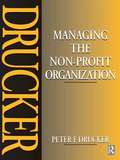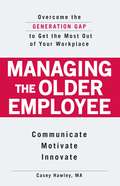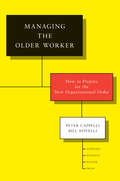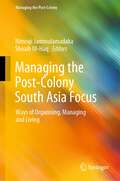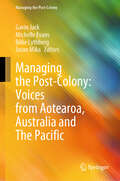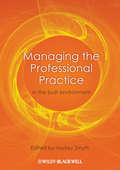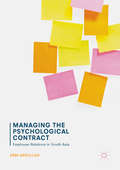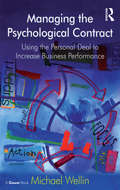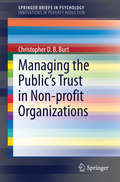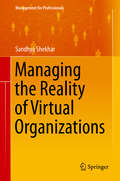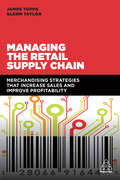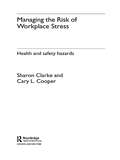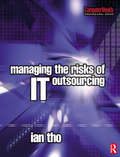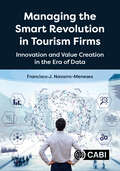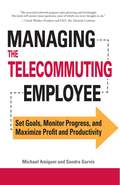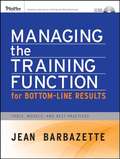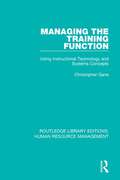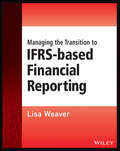- Table View
- List View
Managing the Non-Profit Organization: Principles And Practices
by Peter DruckerA Drucker management classic, first published in 1990, which breaks down any narrow definition of management and is aimed specifically at decision-makers and managers working in non-profit making and charitable organizations to help them apply the principles of good management to their sector. Drawing from the American experience, Drucker poignantly illustrates his discussion of management by quoting his in-depth interviews with top executives from non-profit making organizations. The issues of mission, performance, people and relationships, leadership and developing managers are eloquently discussed and Drucker provides Action Implications throughout the book which are of practical importance to the reader.
Managing the Older Employee
by Casey HawleyGen Yers are coming into their own. Now making up the largest segment of the workforce at 80 million strong, many are new managers. With so many Baby Boomers holding off on retirement, these new Gen Y managers often must direct people their parents' age-and older. Vast differences in communication styles, job expectations, and management techniques mean that Gen Yers have much to learn when it comes to managing those of their parent's generation, including: How to respond to an older employee who believes his seniority guarantees a promotion and raise, even though his work performance has been below average What to do when a younger manager relies on e-mail, texting, and IMing to communicate with coworkers, and his older employee prefers face-to-face communication How to demonstrate leadership and gain respect from the employees who already have years of rich business experience in the workplace This book is every manager's field guide for managing the new generationally diverse workforce.
Managing the Older Employee
by Casey HawleyGen Yers are coming into their own. Now making up the largest segment of the workforce at 80 million strong, many are new managers. With so many Baby Boomers holding off on retirement, these new Gen Y managers often must direct people their parents' age--and older. Vast differences in communication styles, job expectations, and management techniques mean that Gen Yers have much to learn when it comes to managing those of their parent's generation, including:How to respond to an older employee who believes his seniority guarantees a promotion and raise, even though his work performance has been below averageWhat to do when a younger manager relies on e-mail, texting, and IMing to communicate with coworkers, and his older employee prefers face-to-face communicationHow to demonstrate leadership and gain respect from the employees who already have years of rich business experience in the workplaceThis book is every manager's field guide for managing the new generationally diverse workforce.
Managing the Older Employee: Overcome the Generation Gap to Get the Most Out of Your Workplace
by Casey HawleyGen Yers are coming into their own. Now making up the largest segment of the workforce at 80 million strong, many are new managers. With so many Baby Boomers holding off on retirement, these new Gen Y managers often must direct people their parents' age-and older. Vast differences in communication styles, job expectations, and management techniques mean that Gen Yers have much to learn when it comes to managing those of their parent's generation, including:How to respond to an older employee who believes his seniority guarantees a promotion and raise, even though his work performance has been below averageWhat to do when a younger manager relies on e-mail, texting, and IMing to communicate with coworkers, and his older employee prefers face-to-face communicationHow to demonstrate leadership and gain respect from the employees who already have years of rich business experience in the workplace This book is every manager's field guide for managing the new generationally diverse workforce.
Managing the Older Worker
by Peter Cappelli Bill NovelliYour organization needs older workers more than ever: They transfer knowledge between generations, transmit your company's values to new hires, make excellent mentors for younger employees, and provide a "just in time" workforce for special projects.Yet more of these workers are reporting to people younger than they are. This presents unfamiliar challenges that--if ignored--can prevent you from attracting, retaining, and engaging older employees.In Managing the Older Worker, Peter Cappelli and William Novelli explain how companies and younger managers can maximize the value provided by older workers. The key? Recognize that boomers' needs differ from younger generations - and adapt your management practices accordingly. For instance:· Lead with mission: As employees age, they become more altruistic. Emphasize the positive impact of older workers' efforts on the world around them.· Forge social connections: Many older employees keep working to maintain social relationships. Offer tasks that require interaction with others.· Provide different benefits: Tailor benefits--such as elder-care insurance programs or discount medication--to older workers' interests.Drawing on research in management, psychology, and other disciplines, Managing the Older Worker reveals who your older workers are, what they want, and how to manage them for maximum value.
Managing the Olympics
by Daryl Adair Stephen FrawleyThe Olympic Games are the world's most complex and challenging sport mega-event to organize. Managing the Olympics is the first ever attempt to bring together the world's leading Olympic management researchers in one book and draws on the latest research into the management challenges faced by the organizers and key stakeholders of the Games.
Managing the Post-Colony South Asia Focus: Ways of Organising, Managing and Living (Managing the Post-Colony)
by Nimruji Jammulamadaka Shoaib Ul-HaqThis edited book on South Asia is part of the book series “Managing the Post-colony.” This series is co-edited by Nimruji Jammulamadaka and Gavin Jack and is focused on managing and organising within the historical and contemporary structures of colonization and imperialism within and across nation-states and social domains especially the economic and the cultural domain. This edited book on South Asia is committed to a presentation of indigenous understandings and knowledge around the organizing, religion, language and cultural production through the lens of anti, post and de-colonial thought. This book forces the reader to consider not just what we know but how and where we know and can be instrumental in identifying and challenging dominant modes of management knowledge production. The decolonial movement is closely associated with scholars like Walter Mignolo, Anibal Quijano and others who expose how Western rationality and science, emanating from the enlightenment project, are being used by colonial powers to consolidate their imperial projects. The authors in this book argue that a potent form of colonization is epistemic in nature. This book series seeks to present cutting-edge, critical, interdisciplinary, and geographically and culturally diverse perspectives on the contemporary nature, experience and theorization of managing and organizing in post-colonial location under conditions of coloniality. These conditions subsume ongoing and new forms of colonisation/imperialism, and complex resistances to them, and lives lived outside them, and may be drawn out and investigated in regard to a multiplicity of different business- and management-related topics.The power of domination is its ability to silence other ways of knowing, being and doing. Focus on South Asia: Ways of Managing, Organising and Living delivers a profound critique of Western management theory and its universalistic claims. But, it goes much further to advance other managements and ways of organising from the peoples and communities of South Asia. Stella M. Nkomo, University of Pretoria, South Africa I like very much the orientation and the composition of the volume…you have a) the meaning of management in the West changed after the Industrial revolution and by 1900 became a political issue domestically in the US and before that colonial, as you show in the colonial context of South Asia; b) so the constitution of the settler management as you show with McCaulay, destituted all existing local form of organizing their praxis of living; c) the task now is the reconstitution of the destituted, the pluriversal human (and animals too) self-organization subjected to Western regulations to their own benefit, while materializing their rhetoric of racial destitution (incapable of organizing like us, impossible for them to be like, us we have to teach them civilization, etc.). Walter Mignolo, William H. Wannamaker Professor of Literature and Romance Studies at Duke University, USA Very Impressive and Much Needed Pushkala Prasad, Zankel Chair Professor, Skidmore College.
Managing the Post-Colony: Voices from Aotearoa, Australia and The Pacific (Managing the Post-Colony)
by Gavin Jack Michelle Evans Billie Lythberg Jason MikaThis edited book is the second in the book series “Managing the Post-Colony”. The book series is co-edited by Nimruji Jammulamadaka (IIM Calcutta, India) and Gavin Jack (Monash University, Australia). The book series seeks to present cutting-edge, critical, interdisciplinary, and geographically and culturally diverse perspectives on the contemporary nature, experience, and theorisation of managing and organising under conditions of postcoloniality. This book specifically presents voices and perspectives from Aotearoa New Zealand, Australia, and The Pacific, locations with shared and distinctive histories and present-day experiences of colonisation and imperialism. Ways of managing, organising, and doing business in these places demonstrate cultural continuity and change in such histories, present sites of postcolonial struggle, and diverse prospects for self-determined future-making. The book explores struggles and prospects of managing in the post-colony through qualitative empirical cases, historical and legal studies, conceptual essays and provocations, and interviews with Indigenous business leaders. It contributes to the ongoing diversification, provincialisation, and decolonisation of management and organisation studies and practice. A strong focus is placed on diverse Indigenous knowledges and experiences, including those of Aboriginal and Torres Strait Islander, Pasifika, and Māori peoples, and insights into the capacity for Indigenous culture-specific modes of business to offer decolonising futures.
Managing the Professional Practice
by Hedley SmythThe emphasis here is to explore the key issues influencing the culture, strategies and management operations of professional practices. The focus is upon established practices from growing ones to large international firms in the built environment. A key aim of the book is to promote aspects of management by function and activities, with discipline acting as context rather than the primary focus.The book is structured into sections around 3 main themes: managing the organisation; and managing specific issues that affect operations, and a third section reflects upon management from practitioner experience.Section I: 'Managing the organisation' looks at how the history of the firm creates both opportunities and rigidities for developing the practice, in terms of culture and market position, strategies and implementation, financial, marketing and HR management.Section II: 'Managing specific strategic and tactical issues' looks at how these affect approaches a discipline and operational processes in practices. These issues compliment those covered in Section I.Section III: 'Reflecting on practice' covers experience of those in practice and top practitioners detail how they are addressing key issues in their practice and for their discipline. Each chapter by a practitioner has a postscript from academic authors to make links back to research on theory and application.Addresses the key issues facing practice managersCollects latest research from leading academicsOffers comment on current practice from top practitioners
Managing the Psychological Contract
by Abm AbdullahThis book explores the differences between Western and non-Western cultures to provide a more comprehensive understanding of psychological contract and its consequences on employees’ behavioral, attitudinal, and cognitive outcomes. Further, it discusses the culturally-relevant elements of HR practices that affect employee expectations, job satisfaction, commitment, and motivation based on their perceptions of the level of fulfilment of their psychological contract. Integrating both qualitative and quantitative methods, it is the first book to examine the current state of the South Asian workforce and will advance research on industrial relations, employee relationship management, and corporate management of South Asian employees around the world.
Managing the Psychological Contract: Using the Personal Deal to Increase Business Performance
by Michael WellinThe psychological contract lies at the heart of your relationship with the organisation you work for. It is the deal you make with your employer and colleagues at work; it is about your mutual expectations and their fulfilment. Too often this contract is implicit and left to chance, resulting in misunderstanding, stress, lower commitment and performance. The author demonstrates how to use the psychological contract to raise the business game and increase personal fulfilment. Managing the Psychological Contract is the first book which shows how the psychological contract can be used in practice. In it Michael Wellin advocates going beyond the traditional static view of the psychological contract between the organisation and its employees. He shows how to create unique and dynamic customised Personal Deals between people and teams. He does this by showing how to make personal deals explicit and mutual, and provides practical tips for leaders, employees and HR professionals. Separate chapters are devoted to leadership, culture change and strategic HR management. There is also a chapter of practical ideas for individuals who want to change their personal deal at work. The author's ideas are based on his own research and consultancy experience as well as the latest business school research. The book has a number of case studies showing how different organisations use the psychological contract. This is an important and extremely readable book for all those concerned with the improved performance of people and organisations.
Managing the Public's Trust in Non-profit Organizations
by Christopher D.B. BurtGlobally there is growing concern over charities abilities to raise funds. This is of concern to both charity organizations and policy makers. One of the key factors that determine the public's willingness to provide funds (to donate) is trust in both specific charity organizations and the sector in general. A significant amount of research from a number of disciplines has pointed to ways in which the public's trust can be generated and maintained. Bring this research into a single source will provide a valuable guide for both individual charity organizations and policy makers.
Managing the Reality of Virtual Organizations
by Sandhya ShekharThis book comes at a time when virtual organizations(VO), are proliferating exponentially due to the twin catalysts ofglobalization and technological enablement. It provides conceptual frameworksand simple tools for identifying and addressing the complexities of managinggeographically dispersed, virtually linked organizations, which may have grownorganically or inorganically into a potpourri of multiple cultures,capabilities and practices. These can help to scientifically assess the impactof virtualization, balance the physical with the virtual and manage risks usingearly indicators. The book provides mechanisms to recognize, localize, measureand address vulnerabilities. Ensuring knowledge transfer effectiveness (KTE) isvital in VOs. A diagnostic tool has been evolved to measure KTE, isolateproblems and weak links and plan effective interventions. A set of criticalfactors to increase the probability of success of globalization strategies havebeen identified. This book interleaves theory with practice and providesinsights drawn from conversations with business leaders, exploratory surveys,and in-depth research using a large sample. The solid methodologicalunderpinnings serve as a useful template for researchers, while the models canbe contextualized to suit any organization. Foreword by Mr. Ajit Balakrishnan, Chairman and CEO, Rediff. com;Chairman, Board of Governors, Indian Institute of Management Calcutta.
Managing the Retail Supply Chain: Merchandising Strategies that Increase Sales and Improve Profitability
by Glenn Taylor James Topps<p>Buying, merchandising and the supply chain are inextricably linked. Product merchandisers play a key role within retail, as profits can be affected by how successfully they undertake their work. Merchandisers set prices to maximise profits and manage the performance of ranges, planning promotions and mark-downs as necessary. They also oversee delivery and distribution of stock and deal with suppliers. Their connection with and understanding of the supply chain is vital. Supported by theories, explanations and real-life examples, <i>Managing the Retail Supply Chain</i> looks at concepts and core themes that run across all sectors. <p>Many businesses use a one-size-fits-all solution for any issues which arise, leading to big problems. <i>Managing the Retail Supply Chain</i> presents numerous examples of different business models adopted by a variety of companies. Covering basic principles of retail supply chain, KPIs, merchandise planning and demand planning as well as omnichannel, vertical integration, on-shelf availability and e-commerce, <i>Managing the Retail Supply Chain</i> is an essential guide for anyone involved in or studying retail supply chains and merchandising.</p>
Managing the Risk of Workplace Stress: Health and Safety Hazards
by Cary Cooper Sharon ClarkeWorking in a stressful environment not only increases the risk of physical illness or distress, but also increases the likelihood of workplace accidents. While legislation provides some guidelines for risk assessment of physical hazards, there remains limited guidance on the risks of psychosocial hazards, such as occupational stress. This book takes the risk management approach to stress evaluation in the workplace, offering practical guidelines for the audit, assessment and mitigation of workplace stressors. Based on research and case studies, this book provides a comprehensive source of theoretical and practical information for students and practitioners alike. It includes chapters on: * environmental stress factors* psychological stress factors* work-related accidents* job stress evaluation methodsWith its up-to-date approach to a fascinating area of study, this is key reading for all students of organizational psychology and those responsible for workplace safety.
Managing the Risks of Extreme Events and Disasters to Advance Climate Change Adaptation
by Christopher B. Field Vicente Barros Thomas F. Stocker Qin DaheThis Intergovernmental Panel on Climate Change Special Report (IPCC-SREX) explores the challenge of understanding and managing the risks of climate extremes to advance climate change adaptation. Extreme weather and climate events, interacting with exposed and vulnerable human and natural systems, can lead to disasters. Changes in the frequency and severity of the physical events affect disaster risk, but so do the spatially diverse and temporally dynamic patterns of exposure and vulnerability. Some types of extreme weather and climate events have increased in frequency or magnitude, but populations and assets at risk have also increased, with consequences for disaster risk. Opportunities for managing risks of weather- and climate-related disasters exist or can be developed at any scale, local to international. Prepared following strict IPCC procedures, SREX is an invaluable assessment for anyone interested in climate extremes, environmental disasters and adaptation to climate change, including policymakers, the private sector and academic researchers.
Managing the Risks of IT Outsourcing
by Ian ThoThis book shows IT managers how to identify, mitigate and manage risks in an IT outsourcing exercise. The book explores current trends and highlights key issues and changes that are taking place within outsourcing. Attention is given to identifying the drivers and related risks of outsourcing by examining recently published and existing concepts of IT outsourcing. Founded on academic theory and empirical and quantitative information, this book:* Incorporates the complete risk identification and mitigation life cycle* Highlights the concept of core competency * Looks at motivating factors and working relationships of the buyer and supplier* Provides background to understand the risks as a result of ‘human factors’ as defined by the agency theory* Reviews the areas of risk that influence the decision to outsource the IT function* Examines the forces that determine the equilibrium in the risk profiles for the buyer and supplier
Managing the Smart Revolution in Tourism Firms: Innovation and Value Creation in the Era of Data
by Dr Francisco Navarro-MenesesSmart Technologies are revolutionizing tourism, as they promise to change the way tourists behave and how companies interact with them and generate profits. The increasing availability of real-time data in combination with advanced machine learning techniques, artificial intelligence and business analytics, to name but a few, will transform the tourism industry forever and in unthinkable ways. The degree of sophistication achieved by Smart Technologies and the speed with which transformations are taking place means that those people lacking a relevant digital background may lag behind, therefore being unable to take advantage of the opportunities offered by the data economy and fully benefit from its applications. This practical book explains the key ideas that tourism practitioners and decision-makers must know to understand Smart Technologies, and the management principles supporting them. The contents: · Include real-life cases to illustrate to the reader the true dimension of the "smart" phenomenon and the new frontiers that are yet to open in the coming years · Bring together the knowledge and experience of leading experts from the academia, tourism sector and technology companies, who reveal, in a unified way, the fundamental points your organization must consider in the path towards being smarter · Create a practical knowledge tool that allows getting the most out of Smart Technologies, its products and future trends, while learning how to make them a competitive tool, and avoid being left behind · Features full colour figures and photographs The book will be a vital resource for Tourism practitioners, strategic planners and policy makers as well as students of tourism marketing, management and technology
Managing the Strategy Development Process
by Clayton M. Christensen Michael E. RaynorA crucial question that many managers forget to ask about strategy when building a new business relates to the process of strategy formulation that the venture's management team will use to develop and implement a winning plan. This chapter offers two different processes of strategy development and presents a circumstance-based theory to help managers determine which of the processes will be the most reliable source of strategic insight at different stages of business development.
Managing the Telecommuting Employee
by Michael Amigoni Sandra GurvisA bigger and bigger part of the workforce is telecommuting. And managers need new skills to get the most out of this increasingly far-flung staff. This indispensable guide includes case studies, checklists, and sample forms and charts. It shows managers how to use teleconferencing technology to communicate with distanced workers, make the best use of scheduling software to monitor productivity, and even end the arrangement if it's not working. One of the best ways for companies to save money in lean times is to send their employees home to work. But that requires a different kind of workforce and a different kind of management. This book shows how to make the long-distance relationship work for everyone!
Managing the Telecommuting Employee: Set Goals, Monitor Progress, and Maximize Profit and Productivity
by Michael Amigoni Sandra GurvisA bigger and bigger part of the workforce is telecommuting. And managers need new skills to get the most out of this increasingly far-flung staff. This indispensable guide includes case studies, checklists, and sample forms and charts. It shows managers how to use teleconferencing technology to communicate with distanced workers, make the best use of scheduling software to monitor productivity, and even end the arrangement if it's not working.One of the best ways for companies to save money in lean times is to send their employees home to work. But that requires a different kind of workforce and a different kind of management. This book shows how to make the long-distance relationship work for everyone!
Managing the Training Function For Bottom Line Results
by Jean BarbazetteThis book presents time saving strategies, tactics, and a host of job aids to get the best result from the corporate learning function. It will serve both as a must-have reference tool and as a practical survival guide for workplace learning professionals who face unique challenges in accomplishing their responsibilities. Several strategies and tactics are offered to organize the roles and responsibilities of the training function. There's authoritative advice, too, for managing the function including staff management, communicating expectations, setting the learning agenda, coaching subject matter experts, hiring consultants and vendors, managing content, working with learning portals, setting up and managing a learning resource center, marketing and building internal support for training, and integrating learning into the business.
Managing the Training Function: Using Instructional Technology and Systems Concepts (Routledge Library Editions: Human Resource Management #16)
by Christopher GaneThe effective development of human resources within the organisation is one of the most powerful contributions to the long-term growth and survival of the enterprise. This systematic and practical approach to training principles and practice, first published in 1972, provides a unifying framework as a guide to problem solving and action by executives. This step-by-step account, illustrated by case histories, shows how to apply the principles to analysing and solving varied training problems within organisations. This title will be of interest to managers, executives, and students of business studies and human resource management.
Managing the Transformation: A Case Study--Becoming an Adaptive Enterprise
by Stephan H. HaeckelAlthough the sense-and-respond efforts of early adopters are works-in-progress, their experiences of the concept of adaptive enterprise reveal much about the problems and benefits-expected and unexpected-of the ongoing transformation process. This chapter looks at the case of IBM's Palisades Executive Conference Center to offer insights into the process of developing buy-in and commitment to the adoption of a sense-and-respond model.
Managing the Transition to IFRS-Based Financial Reporting
by Lisa WeaverSince 2005, all EU listed companies have been reporting under IFRS in their group accounts. The UK's Accounting Standards Board is proposing that in the next few years all UK companies, other than the smallest, will move to some form of IFRS-based financial reporting. The US is also undergoing a transition to IFRS, as are many other countries such as India and Japan.This book will cover the most common accounting issues involved in a move to IFRS, and deal with the specific accounting and disclosure requirements in the first year of IFRS reporting. Crucially, however, the book will also focus on how to plan and manage the transition, fully exploring the non-accounting implications based on the experience of companies that have already gone through the transition.The book:Provides a clear summary of the main IFRS accounting requirements which are specific to IFRS transitionFocusses on planning and managing the IFRS transition projectEmphasises the non-accounting implications of IFRS transitionConsiders how to best communicate and educate about the IFRS transitionIncludes case studies of companies that have gone through the IFRS transitionManaging the transition to IFRS-based financial reporting does not focus on any specific country, instead offering advice which can be applied in all jurisdictions. This international appeal, coupled with its holistic approach, makes it the one-stop guide to managing this vital transition.
